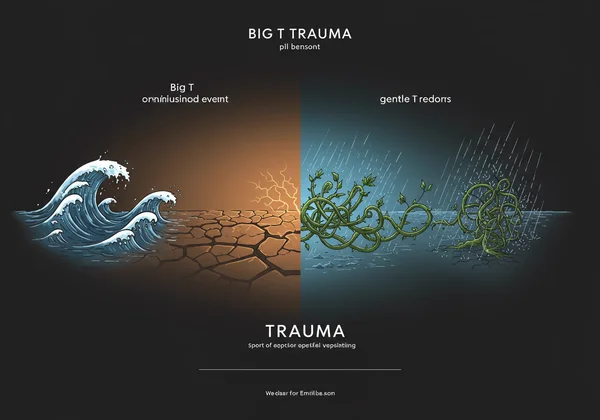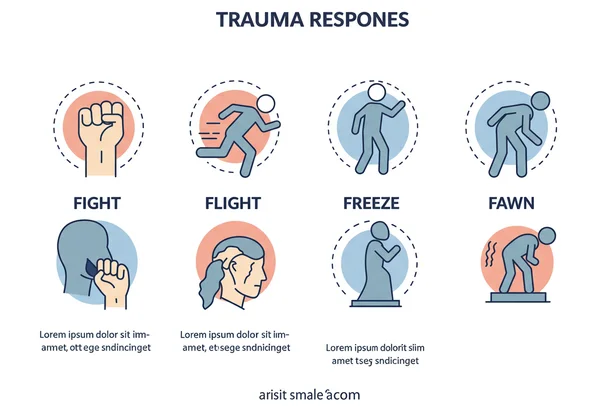Understanding 'Big T' & 'Little t' Trauma: Your Guide to a Trauma Test and Healing
Have you ever minimized your own struggles, thinking they weren't "bad enough" to be called trauma? This is a common feeling. In a world that often highlights dramatic stories, it's easy to believe that only catastrophic events can leave a lasting mark. But how do I know if I have trauma? The answer is more complex and personal than you might think. The truth is, trauma isn't defined by the scale of an event, but by its impact on your nervous system and your life.
Here, we aim to validate your experiences. We will explore the full spectrum of traumatic experiences, from major, life-altering events ("Big T" trauma) to the more subtle but deeply impactful series of distressing events ("little t" trauma). Grasping this distinction is the crucial first step toward acknowledging your feelings and experiences as real. It's about giving yourself the compassion you truly deserve. If you're seeking clarity, beginning with a free trauma test can provide valuable personal insight.

Disclaimer: This blog post is for informational purposes only. The content is not intended to be a substitute for professional medical advice, diagnosis, or treatment. Our online tool is a preliminary screening instrument, not a diagnostic tool. Always seek the advice of your mental health professional or other qualified health provider with any questions you may have regarding a medical condition. Never disregard professional medical advice or delay in seeking it because of something you have read on this website.
What is Trauma? Understanding Its Types and When to Consider a Trauma Test
When we talk about the different types of trauma, we're not creating a hierarchy of pain. Instead, we're building a more inclusive vocabulary to understand the various ways life experiences can shape us. This framework helps validate personal struggles that might otherwise be dismissed. It acknowledges that the emotional weight of an experience is what truly defines it as traumatic.
Defining "Big T" Trauma: Major Life Events
When most people hear the word "trauma," they typically think of "Big T" trauma. These are intense, often life-threatening events that overwhelm a person's ability to cope. They are significant, single-incident experiences that can shatter one's sense of safety and normalcy.
Examples of "Big T" trauma include:
- Experiencing a natural disaster (like an earthquake or hurricane)
- Surviving a serious car accident or physical injury
- Enduring physical or sexual assault
- Experiencing combat or acts of terrorism
- The sudden, unexpected death of a loved one
These events are often associated with Post-Traumatic Stress Disorder (PTSD), but it's important to remember that not everyone who experiences a "Big T" event will develop PTSD. The impact is deeply individual, shaped by personal history and support systems.

Unpacking "Little t" Trauma: The Everyday Burden
"Little t" trauma, or subtle trauma, refers to a series of highly distressing events that, on their own, may not seem life-threatening but are profoundly painful and disruptive. The power of "little t" trauma lies in its cumulative effect. It's like being weathered by a persistent, grinding storm rather than being struck by a single bolt of lightning.
Examples of "little t" trauma include:
- Ongoing emotional neglect or invalidation in childhood
- Persistent bullying or harassment
- A non-life-threatening injury
- The end of a significant relationship or a contentious divorce
- Financial instability or sudden job loss
These experiences can lead to significant emotional distress, anxiety, depression, and relationship difficulties. Because they are often less visible, individuals may be more likely to dismiss their own pain, leading to feelings of shame or confusion. Acknowledging these experiences is a crucial part of the healing process.

Why All Pain Is Valid: Recognizing Trauma Responses Beyond the Obvious
One of the biggest obstacles to healing is emotional invalidation—both from others and from ourselves. We compare our pain, creating a silent rulebook about what "counts" as legitimate suffering. Your nervous system, however, doesn't grade on a curve. It simply responds to perceived threats and overwhelming stress, regardless of whether that stress comes from a "Big T" or a "little t" source. Validating your own experience is a radical act of self-compassion.
The Cumulative Impact: From Chronic Stress to ACEs Test Insights
The concept of chronic stress is central to understanding the impact of "little t" trauma. When the body's stress response system is activated repeatedly without adequate time to recover, it can lead to long-term changes in the brain and body. This is powerfully illustrated by research on Adverse Childhood Experiences (ACEs).
ACEs include experiences like living with a family member with mental health issues, parental separation, or experiencing various forms of abuse. Studies show a strong correlation between the number of ACEs a person has and their risk for health problems in adulthood. This demonstrates that a series of "little t" events can be just as impactful as a single "Big T" event. If these experiences resonate with you, exploring a childhood trauma test can be an illuminating exercise.
Recognizing Your Unique Trauma Response Patterns
How do you react when you feel overwhelmed or threatened? Understanding your go-to coping mechanisms is like finding a map to your inner world. A trauma response test isn't about getting a score, but about identifying your patterns. These responses—often categorized as fight, flight, freeze, or fawn—are automatic survival strategies.
- Fight: Confronting the threat, which can manifest as anger, irritability, or controlling behavior.
- Flight: Escaping the threat, seen as avoidance, anxiety, or constant busyness.
- Freeze: Feeling paralyzed or unable to move or speak, leading to dissociation or feeling numb.
- Fawn: Appeasing the threat to avoid conflict, often resulting in people-pleasing and poor boundaries.
Noticing these patterns isn't a weakness; it's a powerful sign of your resilience. Your brain and body adapted to survive. Now, you can gently begin to identify your trauma response patterns with a sense of understanding.

What Unresolved Trauma Looks Like: Impact on Body, Mind, and Relationships
Whether from a single event or a lifetime of smaller hurts, unresolved trauma can cast a long shadow over your present. It can manifest in ways that seem disconnected from the past, leaving you feeling confused about your own mind and body. Recognizing these signs is not about dwelling on the past, but about empowering yourself with knowledge to move forward.
Physical Manifestations and Emotional Dysregulation
Many people are surprised to learn that trauma is stored in the body. The unresolved energy from overwhelming experiences can lead to very real physical symptoms. This may include chronic fatigue, unexplained aches and pains, digestive problems, or a compromised immune system. Your body holds the score of what you've been through.
Alongside physical symptoms, emotional dysregulation is a common sign. This isn't just "being moody." It's experiencing emotions that feel too big for the situation, struggling with intense anxiety, having a short temper, feeling persistently numb and empty, or swinging between these states. It’s your nervous system struggling to find its baseline of safety.
Impact on Relationships and Daily Life
Trauma fundamentally affects our ability to connect—with ourselves and with others. It can erode our sense of trust, making it difficult to form secure and healthy relationships. You might find yourself avoiding intimacy, struggling to set boundaries, or being drawn to chaotic relationship dynamics that feel familiar.
In daily life, the impact can be subtle but pervasive. You might struggle with focus and concentration, feel a persistent sense of dread, or find it hard to feel joy or excitement. Understanding that these are common after-effects of trauma can reduce self-blame and open the door to healing. Taking a moment to assess the impact of trauma through a structured assessment can provide much-needed clarity.
Your Path to Understanding & Healing Starts Here
Recognizing that trauma exists on a spectrum—from "Big T" to "little t"—is a crucial step. Every experience that has left you feeling overwhelmed, unsafe, or emotionally wounded truly matters. Your pain is valid, and starting to understand it is a courageous step. Healing begins not with judgment, but with gentle curiosity.
If this article has resonated with you, the next step is to explore your own experiences in a safe and private way. Gaining insight into your symptoms and responses is a cornerstone of recovery. We invite you to start your free trauma test on our homepage. It's a confidential, scientifically-designed screening tool that can help you connect the dots and illuminate your path forward.

Frequently Asked Questions About Trauma & Its Impact
What are the 4 types of trauma?
While we've discussed "Big T" and "little t" trauma, mental health professionals often categorize trauma into four main types: Acute Trauma (from a single incident), Chronic Trauma (from repeated, prolonged events like domestic abuse or bullying), Complex Trauma (from varied and multiple traumatic events, often in an interpersonal context), and Secondary/Vicarious Trauma (from exposure to others' trauma, common in first responders and therapists).
How do I know if I have trauma?
There is no single answer, as trauma's effects are unique to each person. Common signs include persistent anxiety, depression, emotional numbness, flashbacks, difficulty with relationships, and unexplained physical symptoms. If you're questioning your experiences, it's a sign that they deserve attention. A screening tool can be a helpful starting point, and you can take a free online trauma test to gain preliminary insight.
What does unresolved trauma look like?
Unresolved trauma often manifests as the symptoms listed above. It can look like chronic people-pleasing (fawning), an explosive temper (fighting), constant anxiety (flight), or feeling disconnected from your life (freezing). It can also appear as chronic pain, trust issues, and a persistent feeling that something is wrong, even when things seem fine on the surface.
Can you self-diagnose trauma?
No, you cannot formally self-diagnose a clinical condition like PTSD. Self-diagnosis can be misleading and overlook other potential issues. However, you can engage in self-exploration and education to better understand your experiences and symptoms. Tools like our online test are for screening and self-awareness, not diagnosis. This understanding is a valuable asset to bring to a conversation with a qualified mental health professional.
What is the most accurate trauma test?
No online quiz can provide a 100% accurate diagnosis. The "most accurate" assessment is always one conducted by a trained clinician who can consider your full life context. However, a high-quality, scientifically-designed screening tool can be a highly reliable first step. Our psychological trauma test was developed with guidance from mental health professionals to provide a dependable preliminary assessment of trauma-related symptoms.